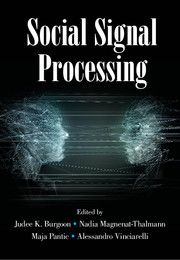Book contents
- Frontmatter
- Contents
- Contributors
- 1 Introduction: Social Signal Processing
- Part I Conceptual Models of Social Signals
- 2 Biological and Social Signaling Systems
- 3 Universal Dimensions of Social Signals: Warmth and Competence
- 4 The Vertical Dimension of Social Signaling
- 5 Measuring Responses to Nonverbal Social Signals: Research on Affect Receiving Ability
- 6 Computational Analysis of Vocal Expression of Affect: Trends and Challenges
- 7 Self-presentation: Signaling Personal and Social Characteristics
- 8 Interaction Coordination and Adaptation
- 9 Social Signals and Persuasion
- 10 Social Presence in CMC and VR
- Part II Machine Analysis of Social Signals
- Part III Machine Synthesis of Social Signals
- Part IV Applications of Social Signal Processing
- References
2 - Biological and Social Signaling Systems
from Part I - Conceptual Models of Social Signals
Published online by Cambridge University Press: 13 July 2017
- Frontmatter
- Contents
- Contributors
- 1 Introduction: Social Signal Processing
- Part I Conceptual Models of Social Signals
- 2 Biological and Social Signaling Systems
- 3 Universal Dimensions of Social Signals: Warmth and Competence
- 4 The Vertical Dimension of Social Signaling
- 5 Measuring Responses to Nonverbal Social Signals: Research on Affect Receiving Ability
- 6 Computational Analysis of Vocal Expression of Affect: Trends and Challenges
- 7 Self-presentation: Signaling Personal and Social Characteristics
- 8 Interaction Coordination and Adaptation
- 9 Social Signals and Persuasion
- 10 Social Presence in CMC and VR
- Part II Machine Analysis of Social Signals
- Part III Machine Synthesis of Social Signals
- Part IV Applications of Social Signal Processing
- References
Summary
As complex beings, humans communicate in complex ways, relying on a range of faculties to encode and decode social messages. Some aptitudes are innate, based on one's biological characteristics, whereas others are acquired, varying according to one's social and cultural experiences. As we explain in this chapter, each of us uses a combination of biological and sociocultural processes to produce and interpret social signals. Our goal is to introduce some of the forms that these processes can take.
We begin this chapter with an overview of social signals and a comparison between the biological and sociocultural processes underlying their production and interpretation. Next, we explore three examples of biologically processed social signals, and then examine sociocultural processing of the same signals. We conclude the chapter by discussing some ways in which biological and sociocultural processes interact.
The Nature of Social Signals
Communicators depend on a wide variety of social signals to make sense of the world around them. Poggi and D'Errico (2011) define a signal as “any perceivable stimulus from which a system can draw some meaning” and a social signal as “a communicative or informative signal which, either directly or indirectly, provides information about ‘social facts,’ that is, about social interactions, social attitudes, social relations and social emotions” (Poggi & D'Errico, 2011: 189). Social interactions are situations in which people perform reciprocal social actions, such as a game, a surgical procedure, an orchestral performance, or a conflict. Social attitudes are people's tendencies to behave in a particular way toward another person or group and include elements such as beliefs, opinions, evaluations, and emotions. Social relations are relationships of interdependent goals between two or more people. Finally, social emotions include those emotions that (1) we feel toward someone else, such as admiration and envy; (2) are easily transmitted from one person to another, such as enthusiasm and panic; and/or (3) are self-conscious, such as pride and shame.
As noted, humans use both biological and sociocultural processes to produce and interpret social signals.
- Type
- Chapter
- Information
- Social Signal Processing , pp. 11 - 22Publisher: Cambridge University PressPrint publication year: 2017
References
- 2
- Cited by



